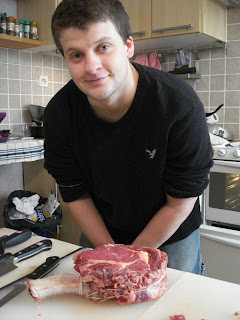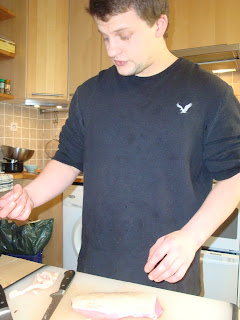My folks arrived a week or so before Christmas with my sister following a few days later. I was still busy with the stage (internship) at Le Cordon Bleu for the first bit of their trip. While I worked in the prep kitchen at school, Marie took our visitors adventuring around Paris.
Onwards and upwards, though.
I have been planning this dinner in my head for at least a month and finally got the menu down on paper with about a week to spare. It was ambitious, using some ingredients I've never used before, in a kitchen that can fit quite cosily two people, with equipment that you could expect to have come with a fully furnished apartment, freshly bought at Ikea.
Here was the goal:
Vol-au-vents of scallops two ways on a bed of leeks, with a scallop jus crème;
Escalope of duck breast and seared pears with a pear balsamic reduction;
Crown roast with Bordelaise-style sauce, and beef marrow;
Glazed allumettes of mixed vegetables in a turned artichoke, Pommes Byron, and glazed baby onions; and
Pumpkin and walnut tart with praline crème anglaise.
Preparation began several days in advance, gathering things like dry butter (a product confined to France, but only available to professionals; the butterfat content is 2% higher than regular butter), hard-for-the-home-cook-to-find things like good veal stock and praline. On the 24th, prep began in earnest with the puff pastry beginnings and most of the knife work (turning carrot, celeriac, and daikon radish into 5mm x 5mm x 3cm matchsticks and making an ultra-fine jullienne of leek).
My feuilletage went well, for the most part remaining even through all six turns. Throughout basic, the chefs have been telling us that making and using it in a 2.5 hour block was sheer insanity, but that we needed to know how to do it. They were right- waiting until the butter is back to firm before continuing in two turn increments, and allowing the finished dough to rest overnight, is the trick!


Since we had guests over, I had to take a break and make lunch to begin the Hutchinson Family Christmas Eve Traditional Dinner: clam chowder.
Lunch was trout filets (oh yeah, there's a reason people don't usually filet trout), rice cooked in fumet, and a green salad. In the natural competitive spirit of my family, my sister Emily decided this would be a great time to hold the Great Plating Challenge of 2010.

I've always wondered what clam chowder would be like with fresh clams, so I opened a kilo of petit point clams with some leftover fumet, white wine, celery and shallot. They turned out pretty darn tasty.
The next morning began rather earlier than planned due to stress dreams about burning my sauces. First up was boiling whole potatoes, skinning them, and pressing them through a strainer with the single most handy kitchen implement ever: the lowly corne. After doing so, they went into a low-heat oven to dry, in order that the maximum amount of water could be replaced, in true French tradition, with fat in the following forms: butter, cream, milk, more butter, more cream, and finally, a little more butter.
Once the potatoes were in to dry, we made the five minute walk over to my folk's rental for Christmas morning. Once done, we all returned to our place with a seven hour deadline.
Next up was meat fabrication: frenching the rib roast and then preparing the breasts of gavage-fattened ducks.


Separately, we had purchased marrow bones that needed to be emptied and their marrow drained of blood.

For the sake of any of you that are squeamish, this picture will suffice.
Magret de canard is a breast from a duck raised for its fattened liver. Generally larger than regular duck breast, with a considerable amount of fat covering the tasty filet, they cannot be beat as far as poultry is concerned. As duck gets tough when it is overcooked, it is served medium rare like steak, but requires a prolonged cooking time on its skin side to render as much fat as possible through shallow incisions the cook makes.




Finally, really breaking into new territory, was dealing with the dozen beautiful scallops. Of the shellfish, they must be one of the easiest to deal with from a strength standpoint- they pop open quite easily and scraping their prized adductor from their shell is no trouble at all. They are not the prettiest things to look at (or clean), and retaining their sea-water aromas means as little rinsing as possible.



With meat fab out of the way, the next step was turning artichokes, a skill we have practiced a few times in Basic Cuisine. While it is a travesty for Californians like my mother, cutting the artichoke down slowly yields only the heart and none of its (admittedly delicious) leaves or hazardous choke. Unfortunately, no pictures of this one. Immediately the hearts are put in floured and acidulated water and brought to a slow simmer.
Ok, maybe a couple pictures (but only 'cause I found them at long last.)



And now, to the flashy part!
The majority of French sauces are unbound reductions, and two of our three sauces fell into this category. The bordelaise style sauce begins with a reduction of Medoc (a whole bottle of the delicious woody-fruity red for about a 1/2 cup of sauce), thyme, bay, garlic, parsley stems and shallot, to which reduced balsamic and a veal demi-glace are added.
For the duck (this one turned out disappointingly dark and acidic- I took my caramel too far), a mild gastric of balsamic vinegar is made and reduced at the same time a jus of duck and pear trimmings, and veal stock is made, and the two are combined and adjusted for consistency. Also, in the hustle, I forgot to throw in the four cloves that set the pear off, so the sauce lacked that certain "Knock!" (LCB'ers, you know that click thing Chef Cotte does).
Next up was a super thick bechamel for the potatoes, flavored with nutmeg and Raclette, cooked slowly to allow the flour to begin it's Maillard-fueled glory, with the cheese mixed it just at the milk finishes cooking into the flour.
'Cause boobs are awesome:
After that, only thing left was to sear off the roast and put it in the oven, begin the duck, assemble the vol-au-vents and cook the scallops!
Et, Voila, as they say:





















No comments:
Post a Comment
If you comment using the "Anonymous" option, please leave your name so I know who you are!